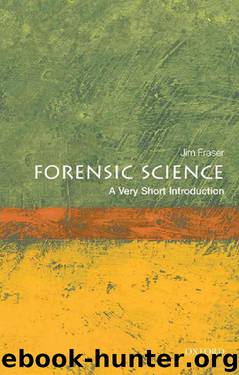Forensic Science: A Very Short Introduction (Very Short Introductions) by Fraser Jim

Author:Fraser, Jim [Fraser, Jim]
Language: eng
Format: mobi, epub
Publisher: Oxford University Press
Published: 2010-02-24T16:00:00+00:00
Chapter 6
Prints and marks: more ways to identify people and things
Marks (or impressions) are caused by a pattern from one item being transferred to another. This could be a shoe mark, a finger mark, or, less obviously, the pattern of striations on a plastic bag made by a tool in the manufacturing process. Firing pins in guns (see Figure 11), as well as saws, tyres, screwdrivers, and feet can all leave marks that can be used to identify the general type of object that made them (a shoe, a tyre) and sometimes even the specific object. This chapter uses fingerprints and shoe marks to illustrate the general characteristics of marks evidence, the principles involved in their examination, and how the evidence is evaluated.
Fingerprints and shoe marks are the most important and frequently encountered evidence of this type. In the view of most marks examiners, identification of an object (or an individual by fingerprints) can be done unequivocally, that is, with 100% certainty. We have everyday experience of marks and have ourselves on occasions made such judgements: who muddied the kitchen floor - a small boy (a shoe mark) or a small dog (a paw mark)? Understanding the application of marks to the investigation of crime is an extension of this everyday experience. Less obvious is how such marks can be used in intelligence databases to analyse crime patterns, or determine if someone should be charged with possession of drugs or possession with intent to supply drugs.
Marks can be visible (patent) or invisible (latent) and require specialist optical, physical, or chemical techniques to visualize them. They can be made in a variety of substances: mud, blood, dust, sweat, soot - referred to as ‘negative’ marks; or by transferring a material to another surface - ‘positive’ marks. A shoe stepping into a pool of blood can leave a negative mark in the blood followed by positive marks on the floor walked upon.
Download
Forensic Science: A Very Short Introduction (Very Short Introductions) by Fraser Jim.epub
This site does not store any files on its server. We only index and link to content provided by other sites. Please contact the content providers to delete copyright contents if any and email us, we'll remove relevant links or contents immediately.
American Kingpin by Nick Bilton(3809)
Future Crimes by Marc Goodman(3555)
The Meaning of the Library by unknow(2530)
Inside the Middle East by Avi Melamed(2320)
Why Nations Fail: The Origins of Power, Prosperity, and Poverty by Daron Acemoglu & James Robinson(2254)
On Tyranny by Timothy Snyder(2202)
Living Silence in Burma by Christina Fink(2046)
Putin's Labyrinth(1983)
The Mastermind by Evan Ratliff(1914)
The Smartest Kids in the World by Amanda Ripley(1825)
Think Like a Rocket Scientist by Ozan Varol(1795)
Law: A Very Short Introduction by Raymond Wacks(1714)
It's Our Turn to Eat by Michela Wrong(1700)
The Rule of Law by Bingham Tom(1667)
Philosophy of law a very short introduction by Raymond Wacks(1638)
Leadership by Doris Kearns Goodwin(1616)
A Dirty War by Anna Politkovskaya(1601)
Information and Communications Security by Jianying Zhou & Xiapu Luo & Qingni Shen & Zhen Xu(1600)
Civil Procedure (Aspen Casebooks) by Stephen C. Yeazell(1528)
